THERE GOES THE NEIGHBORHOOD
Ever since Crimes of the Heart won the Pulitzer Prize for drama in 1981, a cloud of skepticism has followed the award. The announcement that last year’s winner Clybourne Park was coming to Broadway was met with a blend of excitement and cynicism. While Clybourne Park also won several major new play prizes in London, the second-rate The Mountaintop has recently rendered such British accolades meaningless. Clybourne Park arrives on Broadway with plenty of pedigree, but does it live up to its hype?
In 2010, Bruce Norris’s play received a fairly successful production at Playwrights Horizons. The same production then traveled to Los Angeles while a different production was mounted at Steppenwolf where many of Norris’s plays have premiered. Norris has made a name for himself as a playwright who holds the feet of self-congratulatory Progressives up to the fire, exposing Limousine Liberals and Cocktail Party Marxist, warts and all. If Norris were indeed genuinely interested in fathoming progressive hypocrisy, Clybourne Park might have been a great play. Instead we’re given a play that has the depth of a game of Truth or Dare, and a production ill-suited for its new midtown Manhattan digs.
In Clybourne Park, there’s no real plot or main character, per se, as the neighborhood of Clybourne Park is the only thing transforming in this play. Norris has constructed the first act of his play around what he imagined was happening offstage in A Raisin in the Sun in Mama’s future house in the white neighborhood while Mama herself was planning her move out of the projects. It’s a clever conceit, albeit a bit predictable, as we know the outcome. Something that always bothers me about Lorraine Hansberry’s play is that there is no verisimilitude in A Raisin in the Sun when it comes to Mama’s actual purchase of real estate. She does not have the full amount saved for the middle-class Chicago home in 1959, yet somehow Mama is spared the headache of banks, mortgages, brokers, and escrow.
Similarly, Norris is not interested in the verisimilitude of 21st-century American multiculturalism. The second act of the play takes place 50 years later when a white family wants to move into the same house Hansberry’s Mama bought, now a rundown mess. Norris constructs his arguments around an oversimplified protest of good taste. An African-American couple from a powerful neighborhood committee wants to maintain the aesthetic values of the one-story, single-family neighborhood for sentimental reasons, according to the script. The upwardly mobile white family who purchases the house, however, wants to raze the building and build a two-story home. By making the play’s argument about taste instead of the underlying financial issues, Norris completely misses an opportunity for an honest discussion of race and class while minimizing the full impact of his play. The actual consequence of building larger homes in Clybourne Park would be that the value of the neighborhood properties would increase, and with it, an increase in property taxes, which is good for the municipality if not for the individuals who might no longer be able to afford to live there. But that’s not the direction Norris’ play takes. Instead, he leads us down an entertaining cul de sac in the form of a racially offensive joke competition. It’s not only a cheap distraction, but also ultimately irresponsible as the contemporary world of diversity in Clybourne Park is tethered to a late 1960s idea of black/white Civil Rights, with the exception of one minor gay reference. A play about Progressives that takes place in 2009 with lines like “half of my friends are black” – not to mention a play about progressives, race, and real estate without a single mention of Asians, Latinos, or Persians, – simply feels out of date.
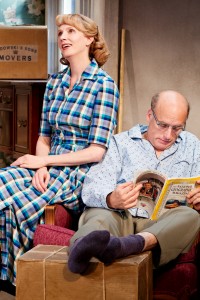 Director Pam MacKinnon’s production at the Walter Kerr Theatre makes so many missteps, it nearly trips over itself. She can’t seem to decide if we’re to take the characters seriously or reduce them to satire and stereotypes. The fun of this sort of play is that the actors get to play two very different characters from two different time periods. The performances MacKinnon encourages are regretfully uneven. I had been told Frank Wood gave a revelatory performance as a grieving father in Act One, but his words get swallowed in the Walter Kerr to the point where I couldn’t understand half of his lines. Both of Crystal Dickinson’s characters are noble, righteous black women, and she plays them both very one-note, unfortunately the same note. Jeremy Shamos solidly drives the second act as Steve, the well-intended and very entitled white guy whose lack of diplomacy gets the racism rolling. Annie Parisse delivers the most interesting performance as a deaf pregnant woman in Act One, but the way she plays the more confident pregnant professional in Act Two comes off as foolish and annoying. No one is more annoying than Christina Kirk as the tightly wound housewife in Act One and the tightly wound lawyer in Act Two. A better director would have toned Kirk’s overly-gestured performance down or redirected it entirely. Maybe the intent of MacKinnon’s production is to bite the hand that feeds it and annoy the predominantly Liberal/Progressive Broadway audience.
Director Pam MacKinnon’s production at the Walter Kerr Theatre makes so many missteps, it nearly trips over itself. She can’t seem to decide if we’re to take the characters seriously or reduce them to satire and stereotypes. The fun of this sort of play is that the actors get to play two very different characters from two different time periods. The performances MacKinnon encourages are regretfully uneven. I had been told Frank Wood gave a revelatory performance as a grieving father in Act One, but his words get swallowed in the Walter Kerr to the point where I couldn’t understand half of his lines. Both of Crystal Dickinson’s characters are noble, righteous black women, and she plays them both very one-note, unfortunately the same note. Jeremy Shamos solidly drives the second act as Steve, the well-intended and very entitled white guy whose lack of diplomacy gets the racism rolling. Annie Parisse delivers the most interesting performance as a deaf pregnant woman in Act One, but the way she plays the more confident pregnant professional in Act Two comes off as foolish and annoying. No one is more annoying than Christina Kirk as the tightly wound housewife in Act One and the tightly wound lawyer in Act Two. A better director would have toned Kirk’s overly-gestured performance down or redirected it entirely. Maybe the intent of MacKinnon’s production is to bite the hand that feeds it and annoy the predominantly Liberal/Progressive Broadway audience.
To compound matters, the production design is unremarkable. Daniel Ostling’s ordinary living room set can be found on any regional theatre or Off-Broadway stage. Similarly, John Gromada’s sound and Allen Lee Hughes’ lights are workmanlike and hardly merit the price of a Broadway ticket. Only Ilona Somogyi’s costumes slyly inform us of the play’s underlying class and racial issues. The unmet challenges of bringing Clybourne Park to Broadway are all too clear as the actors, the direction, and the production don’t quite belong in this new neighborhood, not unlike the characters in the play itself. A smaller, more intimate downtown venue or regional theatre seems much more apropos.
Ultimately, it’s Norris’s play that lacks the Broadway curb appeal. It walks away when it should embrace. It jokes when it should act with sincerity. It’s reductive when it should be expansive. Norris seems more interested in making fun of bourgeois Progressives than in writing a play that fathoms causes and solutions to the problems of inner city gentrification and its societal resonance. Once again the Pulitzer committee has proven itself an unworthy bellwether.
photos by Nathan Johnson
Clybourne Park
The Playwrights Horizons Production
Walter Kerr Theatre in New York City
ends on July 15, 2012 EXTENDED to September 2, 2012
for tickets, visit Clybourne Park
review of Clybourne Park at Steppenwolf in Chicago
review of Clybourne Park at Mark Taper Forum in Los Angeles
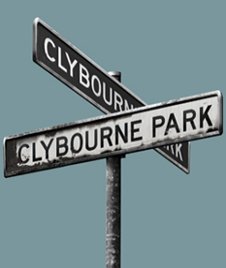
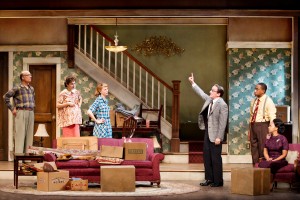
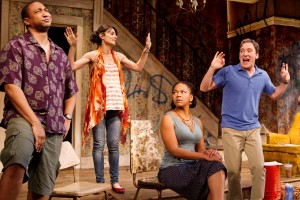
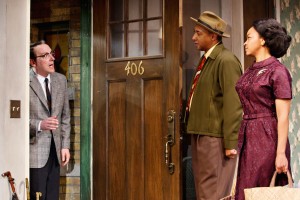

{ 1 comment… read it below or add one }
For me, your critique is blunted by your astounding inability to use your eyesight. The play’s setting is a two-story house as evidenced by the staircase prominently positioned and oft-used. Your powers of obersvation (or, more to the point, lack thereof) make the rest of your complaints about CLYBOURNE PARK suspect as far as I’m concerned.
Re “a play about progressives, race, and real estate without a single mention of Asians, Latinos, or Persians, – simply feels out of date”: Why stop with only three cultures/races? Surely you can come up with a more comprehensive (and apparently mandatory) quota system than that.